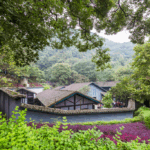“Clear waters and lush mountains are invaluable assets.” This concept, proposed two decades ago, has become a consensus and guiding principle for ecological civilization, forming a core tenet of contemporary environmental thought.
In March 2020, a revisit to Yu Village in Anji County, Zhejiang, revealed transformative progress. Observing the village’s achievements, it was affirmed: “The success of Yu Village proves that the path of green development is correct. Once the right path is chosen, we must persist.”
The results are evident across landscapes and in the hearts of millions:
China has become the fastest-improving country in air quality, with PM2.5 levels in key cities dropping by approximately 60% from 2013 to 2024.
It leads globally in afforestation, contributing a quarter of the world’s new green areas.
Historic progress has been made in combating desertification, achieving “zero growth” in land degradation and reducing both desertified and sandy areas.
The nation has built the world’s largest and fastest-growing renewable energy system, along with the most comprehensive new energy industrial chain.
Commitments to peak carbon emissions by 2030 and achieve carbon neutrality by 2060 have been made to the world.
These milestones underscore unprecedented determination, effort, and results, reflecting transformative changes of historical significance.
Ecological achievements stand as a hallmark of progress in the new era.
Theoretical Foundations
“Transitioning from practical exploration to scientific guidance”
A river exemplifies the power of scientific theory in practice.
The Xin’an River, a shared lifeline for Anhui and Zhejiang, tells a story of ecological compensation. “Thanks to the Xin’an River mechanism, cross-regional cooperation has improved water quality from Grade II to Grade I, benefiting communities upstream and downstream,” explained an official from Jixi County.
Once plagued by industrialization’s pollution, the river’s revival addresses a modern dilemma: how to balance development and conservation, especially across regions.
“Avoiding the old path of pollution before treatment,” a pioneering compensation mechanism was launched in 2012, evolving into a model for collaborative ecological protection and shared prosperity.
In 2019, it was emphasized: “The Xin’an River experience should be expanded, encouraging diverse compensation approaches between upstream and downstream regions.”
From pilot projects to regional cooperation, ecological thought has reshaped perspectives, uniting officials across provinces.
Rivers nurture civilizations. Strategic visions like the “National River Strategy” have been outlined, emphasizing protection over exploitation for the Yangtze and Yellow Rivers.
Over the past decade, surface water quality has significantly improved, with 90.4% of monitored sections now rated excellent—a leap from 64.1% a decade ago.
“Ecological conservation has always been a priority in my work,” recalled a leader, underscoring its political and practical importance.
Modernization demands new answers: Why build an ecological civilization? What kind? How?
“China’s path cannot follow the old ways of the West,” came the warning. “We must choose—what do we truly want?”
Confronting national and global challenges, ecological progress was elevated to unprecedented heights:
Integrated into the “Five-Sphere Integrated Plan,” it became a pillar of national strategy.
Harmony between humanity and nature was enshrined as a guiding principle.
Green development emerged as a core tenet of new development philosophies.
Pollution prevention joined the “Three Critical Battles.”
A “Beautiful China” was set as a mid-century goal.
Ecological efforts have remained central to governance, reflecting profound political and philosophical commitment.
“Strengthening ecological protection isn’t just an economic issue—it carries deep political significance,” it was noted.
Major incidents, like the Qinling Mountains violations, prompted strict directives: “Address not just the symptoms but the political discipline breaches.”
In 2018, ecological thought was formally articulated, providing a theoretical compass.
The 20th Party Congress in 2022 highlighted “harmony between humanity and nature” as a defining feature of Chinese modernization.
By 2023, further refinements addressed key relationships and strategies for ecological advancement.
“We’ve deepened our understanding of ecological laws, transitioning from practice to scientifically guided action.”
This thought integrates Marxist principles with Chinese realities and traditional wisdom, offering systematic solutions:
Bal



